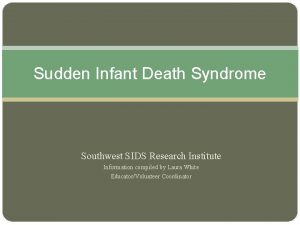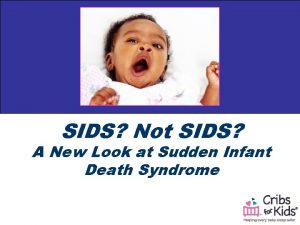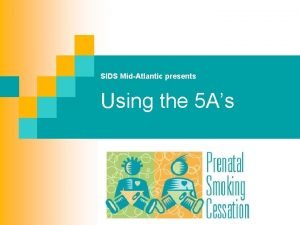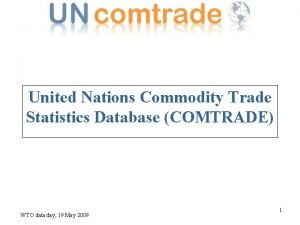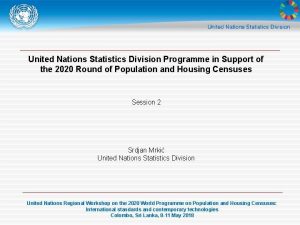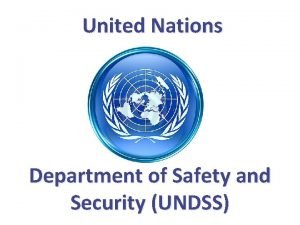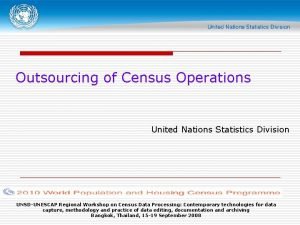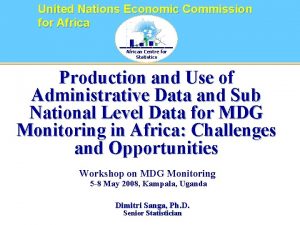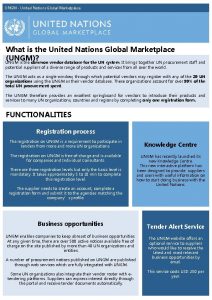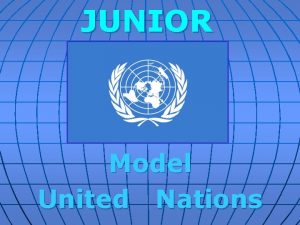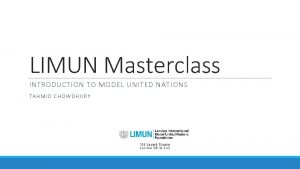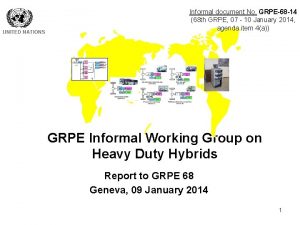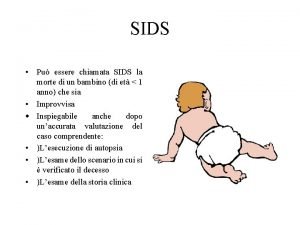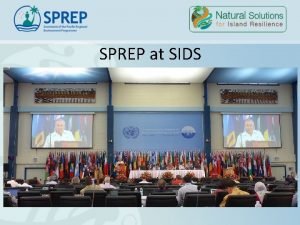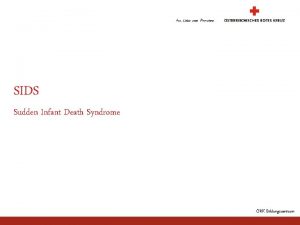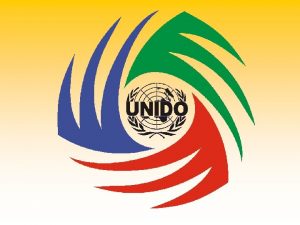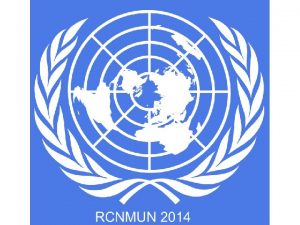United Nations ICT 4 SIDS Partnership www ict

























- Slides: 25

United Nations ICT 4 SIDS Partnership (www. ict 4 sids. com) Smart Hubs for Smart Islands and Communities Amjad Umar, Ph. D. , Director and Chief Architect, United Nataions ICT 4 SIDS Partnership Director and Professor of ISEM Program, Harrisburg University of Science & Technology Advisory Team: Robert St Thomas, IBM (Retired) John Steffens, Ph. d. (Oklahoma University) Dr John Kenerson, World Hypertension League Peter Kenilorea, United Nations Note: The Software is Developed by the NGE Solutions Team v 2

Example: “Smart Solomon” Islands • Population of 0. 6 million • 900 small islands (100 mile x 100 mile). • 85% of the population is in 900 islands. • No schools beyond primary education • No healthcare facilities • Capital city (Honiara) • Only large city • Decent schools & healthcare • Only 15% of the population • 2 to 5 hours to transport a patient from an island to a hospital in Honiara. • Kids sent to Honiara for education at risk • Middle class income USD 500 per month • USD 1200 per month for a 1 Mbps line

“Smart Solutions” – Reality Check Goals • Health, Education, Safety, Welfare, etc • UN Sustainable Development Goals (17 SDGs) Location: • Rural vs Urban (50 -50) • Developed (40) vs Developing (150) • Technology and Energy Smart Hubs Smart (KDAL) • Knowledge • Detect • Adjust • Learn Implementation Approach • People, Processes and Technologies Tradeoffs • Collaboration for wider impact

https: //www. youtube. com/watch? v=uphifd-Uuys

Our Vision: Smart Hubs • • Highly specialized Hubs in different locations Address UN Sustainable Development Goals (SDGs) Supported by Smart Portals that can Detect, Adjust, Learn Distributed collaborative architecture Subject Matter Experts Rural Solar Hub (Health) Healthcare Center Rural Hub (Agriculture) Education Center Regional Hub (Education) National Hub (Disaster Mgmt) Communications and Collaboration DRM Center Global Center BI Center Other Centers Administrators and Analysts

Let’s Demonstrate 1. Explore the ICT 4 SIDS Demo Site. • Visit www. ict 4 sids. com Site • Video on ICT 4 SIDS – https: //youtu. be/Eq. Heoz. Rcu. GA • Video on SDG Advisor https: //youtu. be/QQBHo 0 k. Of. U 8 2. (Backup) Demo based on Screenshots In-session demo(Slide 14) • Come back to Slide 7 to Conclude the Presentation

How to Get Started

SMART CITIES & ENTERPRISE: Graduate Education at HU ISEM (Information Systems Engineering & Management)- Grad Program n Focus on different aspects of Digital Enterprises (e. g. , Smart Enterprires) u u u IS = latest technologies (e. g. , Digital Technologies) SE = Systems Engineering, consider people, processes and technologies EM = Engineering Management (planning, engineering, management) Concentration in Smart Enterprises • • ISEM 572: Smart Enterprises and Strategic Intelligence ISEM 500: Strategic Planning, Engineering and Management of Digital Enterprises Other courses in Digital Technologies, Analytics, Project Management, etc Capstone: Applied Projects

Training: Certificate for IT Officials • All courses are offered completely online as hands-on workshops. In-Class and Hybrid delivery methods can be made available on demand. • The Program consists of three core courses (C 1, C 2, C 3), and one capstone. • Additional courses may be offered in ICT applications in specific areas such as education, agriculture, business, food safety, health, and public welfare as needed. • Each course (12 hours of instruction) is divided into four sessions (3 hours each). Course C 1: Smart Enterprises

Smart Hubs for Smart Solutions Sustainable Goals • Health, Education, Safety, Welfare, etc • Example: UN Sustainable Development Goals (SDGs) Location: • Rural vs Urban (50 -50) • Developed (40) vs Developing (150) • Technology and Energy Smart Hubs Smart Portals • Knowledge • Detect • Adjust • Learn Implementation Approach • People, Processes and Technologies Tradeoffs • Collaboration for wider impact

Concluding Comments Main Idea: Smart hubs that offer location specific services and collaborate with each other Lessons Learned and Insights Gained Ø More data and knowledge does not necessarily lead to better decisions –decision support tools do Ø Do not declare victory too early or accept defeat too soon Ø Pay more attention to value provided and not just to volume (no of partners, no of people involved, amount of funding), etc

Thank You To Get Started: www. ict 4 sids. com Amjad Umar, Ph. D. umar@amjadumar. com 717 -901 -5141

Offline Demo based on Screenshots of ICT 4 SIDS Site Ø Show the ICT 4 SIDS Site Ø The video clip Ø Methodology Ø SDG Advisor


Video: Phttps: //youtu. be/Eq. Heoz. Rcu. GA

Global ICT 4 SIDS Center Collaborations - Horizontal - Vertical - Diagonal Examples: • healthcare i same island • schools from different islands • DRM with Healthcare • Regional economic developmen




Phase 1: SDG Advisor

SDG Advisor – Step 2

PHASE 2: Computer Aided Planning

Outputs Produced by the e. Planner

Outputs Produced by the e. Planner - Working Hub Portal

Go Back to Main Presentation (Slide 6)
 Triple risk model sids
Triple risk model sids Triple risk model sids
Triple risk model sids Sids mid atlantic
Sids mid atlantic Triple risk model sids
Triple risk model sids United nations basic principles on the role of lawyers
United nations basic principles on the role of lawyers What is the role of the united nations?
What is the role of the united nations? United nations commodity trade statistics database
United nations commodity trade statistics database United nations statistics division
United nations statistics division United nations zambia
United nations zambia Opsp united nations
Opsp united nations Undss security
Undss security United nations
United nations United nations road safety
United nations road safety United nations statistics division
United nations statistics division Ethics and integrity at the united nations
Ethics and integrity at the united nations Unicef is mandated by the
Unicef is mandated by the Aitor arauz chapman
Aitor arauz chapman United nations
United nations Unmg
Unmg United nations economic commission for europe
United nations economic commission for europe Christian saunders united nations
Christian saunders united nations Junior model united nations
Junior model united nations Introduction to model united nations
Introduction to model united nations Class 7 dangerous goods
Class 7 dangerous goods United nations
United nations Model united nations
Model united nations
